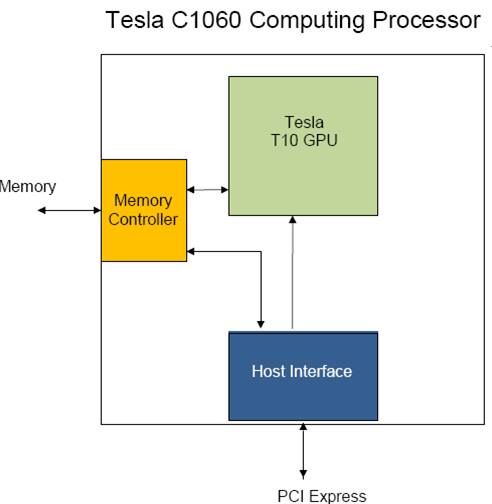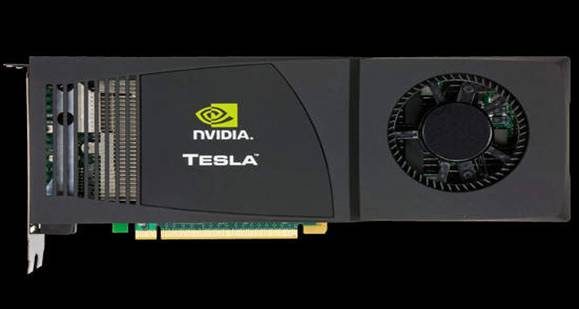Abstract of NVIDIA Tesla Personal Supercomputer
The Tesla Personal Supercomputer is a desktop computer that is backed by Nvidia and built by Dell, Lenovo and other companies. It is meant to be a demonstration of the capabilities of Nvidia's Tesla GPGPU brand; it utilizes NVIDIA's CUDA parallel computing architecture and powered by up to 960 parallel processing cores, which allows it to achieve a performance up to 250 times faster than standard PCs, according to Nvidia. At the heart of the new Tesla personal supercomputer are three or four Nvidia Tesla C1060 computing processors, which appear similar to a high-performance Nvidia graphics card, but without any video output ports.
At the heart of the new Tesla personal supercomputer are three or four Nvidia Tesla C1060 computing processors, which appear similar to a high-performance Nvidia graphics card, but without any video output ports. Each Tesla C1060 has 240 streaming processor cores running at 1.296 GHz, 4 GB of 800 MHz 512-bit GDDR3 memory and a PCI Express x16 system interface. While typically using only 160-watts of power, each card is capable of 933 GFlops of single precision floating point performance or 78 GFlops of double precision floating point performance.
At the heart of the new Tesla personal supercomputer are three or four Nvidia Tesla C1060 computing processors, which appear similar to a high-performance Nvidia graphics card, but without any video output ports. Each Tesla C1060 has 240 streaming processor cores running at 1.296 GHz, 4 GB of 800 MHz 512-bit GDDR3 memory and a PCI Express x16 system interface. While typically using only 160-watts of power, each card is capable of 933 GFlops of single precision floating point performance or 78 GFlops of double precision floating point performance.
Introduction of NVIDIA Tesla Personal Supercomputer
NVIDIA (Nasdaq: NVDA) is the world leader in visual computing technologies and the inventor of the GPU, a high-performance processor which generates breathtaking, interactive graphics on workstations, personal computers, game consoles, and mobile devices. NVIDIA serves the entertainment and consumer market with its GeForce® products, the professional design and visualization market with its Quadro® products, and the high-performance computing market with its Tesla™ products. NVIDIA is headquartered in Santa Clara, California, and has offices throughout Asia, Europe, and the Americas. Certain statements in this press release including, but not limited to, statements as to: the benefits, features, impact, and capabilities of the Tesla GPU computing processor and CUDA architecture; are forward-looking statements that are subject to risks and uncertainties that could cause results to be materially different than expectations.
Important factors that could cause actual results to differ materially include: development of more efficient or faster technology; adoption of the CPU for parallel processing; design, manufacturing or software defects; the impact of technological development and competition; changes in consumer preferences and demands; customer adoption of different standards or our competitor's products; changes in industry standards and interfaces; unexpected loss of performance of our products or technologies when integrated into systems; as well as other factors detailed from time to time in the reports NVIDIA files with the Securities and Exchange Commission including its Form 10-K for the fiscal period ended January 25, 2009.
Copies of reports filed with the SEC are posted on our website and are available from NVIDIA without charge. These forward-looking statements are not guarantees of future performance and speak only as of the date hereof, and, except as required by law, NVIDIA disclaims any obligation to update these forward-looking statements to reflect future events or circumstances.
Important factors that could cause actual results to differ materially include: development of more efficient or faster technology; adoption of the CPU for parallel processing; design, manufacturing or software defects; the impact of technological development and competition; changes in consumer preferences and demands; customer adoption of different standards or our competitor's products; changes in industry standards and interfaces; unexpected loss of performance of our products or technologies when integrated into systems; as well as other factors detailed from time to time in the reports NVIDIA files with the Securities and Exchange Commission including its Form 10-K for the fiscal period ended January 25, 2009.
Copies of reports filed with the SEC are posted on our website and are available from NVIDIA without charge. These forward-looking statements are not guarantees of future performance and speak only as of the date hereof, and, except as required by law, NVIDIA disclaims any obligation to update these forward-looking statements to reflect future events or circumstances.
Processor of NVIDIA Tesla:

KEY FEATURES
GPU
<< Number of processor cores: 240<< Processor core clock: 1.296 GHz
<< Voltage: 1.1875 V
<< Package size: 45.0 mm × 45.0 mm 2236-pin flip-chip ball grid array (FCBGA)
Memory
<< 800 MHz<< 512-bit memory interface
<< 4 GB: Thirty-two pieces 32M × 32 GDDR3 136-pin BGA, SDRAM

External Connectors
<< None
Internal Connectors and Headers
<< One 6-pin PCI Express power connector<< One 8-pin PCI Express power connector
<< 4-pin fan connector
Tesla Architecture
• Massively-parallel many-core architecture• 240 scalar processor cores per GPU
• Integer, single-precision and double-precision floating point operations
• Hardware Thread Execution Manager enables thousands of concurrent threads per GPU
• Parallel shared memory enables processor cores to collaborate on shared information at local cache performance
• Ultra-fast GPU memory access with 102 GB/s peak bandwidth per GPU
• IEEE 754 single-precision and double-precision floating point
• Each Tesla C1060 GPU delivers 933 GFlops Single Precision and 78 GFlops Double Precision performance
No comments:
Post a Comment